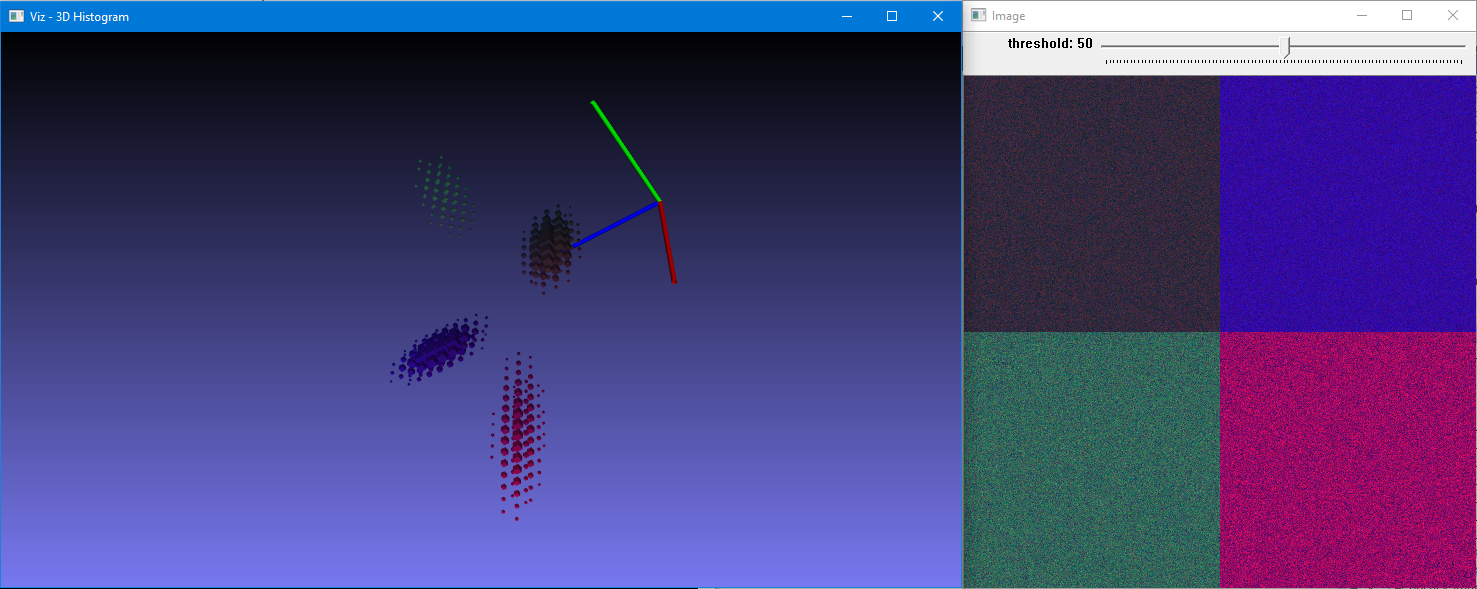#include <iostream>
#ifdef HAVE_OPENCV_VIZ
"{Aide h usage ? help | | print this message }"
"{@arg1 | | Full path to color imag (3 channels)}"
;
struct Histo3DData {
int seuil;
double threshold;
int nbWidget;
bool status;
double maxH;
int code;
};
void DrawHistogram3D(Histo3DData &);
void AddSlidebar(
String sliderName,
String windowName,
int sliderMin,
int sliderMax,
int valeurDefaut,
int *sliderVal,
void(*f)(
int,
void *),
void *r);
void UpdateThreshold(int , void * r);
void DrawHistogram3D(Histo3DData &h)
{
int planSize = (int)h.histogram.step1(0);
int cols = (int)h.histogram.step1(1);
int rows = (int)planSize / cols;
int plans = (int)h.histogram.total() / planSize;
h.fen3D->removeAllWidgets();
h.nbWidget=0;
if (h.nbWidget==0)
for (int k = 0; k < plans; k++)
{
for (int i = 0; i < rows; i++)
{
for (int j = 0; j < cols; j++)
{
double x = h.histogram.at<float>(k, i, j);
if (x >= h.threshold)
{
double r=std::max(x/h.maxH,0.1);
viz::WCube s(
Point3d(k - r / 2, i - r / 2, j - r / 2),
Point3d(k + r / 2, i + r / 2, j + r / 2),
false,
viz::Color(j /
double(plans) * 255, i /
double(rows) * 255, k /
double(cols) * 255));
h.fen3D->showWidget(format("I3d%d", h.nbWidget++), s);
}
}
}
}
h.status = false;
}
{
Histo3DData *x=(Histo3DData *)t;
cout <<
"您按下了 "<< w.
symbol<<
" 在 viz 窗口中 "<<x->fen3D->getWindowName()<<
"\n";
case '/'
x->status=true;
x->threshold *= 0.9;
break;
case '*'
x->status = true;
x->threshold *= 1.1;
break;
}
if (x->status)
{
cout << x->threshold << "\n";
DrawHistogram3D(*x);
}
}
void AddSlidebar(
String sliderName,
String windowName,
int sliderMin,
int sliderMax,
int defaultSlider,
int *sliderVal,
void(*f)(
int,
void *),
void *r)
{
}
void UpdateThreshold(int , void * r)
{
Histo3DData *h = (Histo3DData *)r;
h->status=true;
h->threshold = h->seuil/1000000.0;
cout<<"Widget : "<<h->nbWidget<<","<< h->threshold<<"\n";
}
int main (
int argc,
char **argv)
{
if (parser.has("help"))
{
parser.printMessage();
return 0;
}
if (nomFic.length() != 0)
{
img =
imread(nomFic, IMREAD_COLOR);
if (img.empty())
{
cout << "图像不存在!";
return 0;
}
}
else
{
parser.printMessage();
r.
fill(img(
Rect(0, 0, 256, 256)), RNG::NORMAL,
Vec3b(60, 40, 50),
Vec3b(10, 5, 20));
r.
fill(img(
Rect(256, 0, 256, 256)), RNG::NORMAL,
Vec3b(160, 10, 50),
Vec3b(20, 5, 10));
r.
fill(img(
Rect(0, 256, 256, 256)), RNG::NORMAL,
Vec3b(90, 100, 50),
Vec3b(10, 20, 20));
r.
fill(img(
Rect(256, 256, 256, 256)), RNG::NORMAL,
Vec3b(100, 10, 150),
Vec3b(10, 5, 40));
}
Histo3DData h;
h.status=true;
h.seuil=90;
h.threshold= h.seuil/1000000.0;
float hRange[] = { 0, 256 };
const float* etendu[] = { hRange, hRange,hRange };
int hBins = 32;
int histSize[] = { hBins, hBins , hBins };
int channel[] = { 2, 1,0 };
calcHist(&img, 1, channel,
Mat(), h.histogram, 3, histSize, etendu,
true,
false);
normalize(h.histogram, h.histogram, 100.0/(img.total()), 0, NORM_MINMAX, -1,
Mat());
minMaxIdx(h.histogram,NULL,&h.maxH,NULL,NULL);
AddSlidebar("threshold","Image",0,100,h.seuil,&h.seuil, UpdateThreshold,&h);
h.fen3D = makePtr<viz::Viz3d>("3D 直方图");
h.nbWidget=0;
h.fen3D->registerKeyboardCallback(KeyboardViz3d,&h);
DrawHistogram3D(h);
while (h.code!=27)
{
h.fen3D->spinOnce(1);
if (h.status)
DrawHistogram3D(h);
if (h.code!=27)
}
return 0;
}
#else
int main(
int argc,
char **argv)
{
cout << " 您需要 VIZ 模块\n";
return 0;
}
#endif
专为命令行解析而设计。
定义 utility.hpp:820
用于通过其坐标 x、y 和 z 指定的 3D 点的模板类。
定义 types.hpp:255
void fill(InputOutputArray mat, int distType, InputArray a, InputArray b, bool saturateRange=false)
用随机数填充数组。
用于 2D 矩形的模板类。
定义 types.hpp:444
用于短数值向量的模板类,是 Matx 的特例。
定义 matx.hpp:369
此类以 BGR 顺序表示颜色。
定义 types.hpp:64
此类表示键盘事件。
定义 types.hpp:288
String symbol
定义 types.hpp:303
Action action
定义 types.hpp:302
unsigned char code
定义 types.hpp:304
此 3D 小部件定义了一个立方体。
定义 widgets.hpp:373
void minMaxIdx(InputArray src, double *minVal, double *maxVal=0, int *minIdx=0, int *maxIdx=0, InputArray mask=noArray())
在数组中查找全局最小值和最大值。
void normalize(InputArray src, InputOutputArray dst, double alpha=1, double beta=0, int norm_type=NORM_L2, int dtype=-1, InputArray mask=noArray())
归一化数组的范数或值范围。
std::string String
定义 cvstd.hpp:151
std::shared_ptr< _Tp > Ptr
定义 cvstd_wrapper.hpp:23
#define CV_8UC3
定义 interface.h:90
void imshow(const String &winname, InputArray mat)
在指定窗口中显示图像。
int waitKey(int delay=0)
等待按下键。
void namedWindow(const String &winname, int flags=WINDOW_AUTOSIZE)
创建一个窗口。
void setTrackbarPos(const String &trackbarname, const String &winname, int pos)
设置轨迹条的位置。
void setTrackbarMax(const String &trackbarname, const String &winname, int maxval)
设置轨迹条的最大位置。
void setTrackbarMin(const String &trackbarname, const String &winname, int minval)
设置轨迹条的最小位置。
int createTrackbar(const String &trackbarname, const String &winname, int *value, int count, TrackbarCallback onChange=0, void *userdata=0)
创建一个轨迹条并将其附加到指定的窗口。
CV_EXPORTS_W Mat imread(const String &filename, int flags=IMREAD_COLOR)
从文件加载图像。
void calcHist(const Mat *images, int nimages, const int *channels, InputArray mask, OutputArray hist, int dims, const int *histSize, const float **ranges, bool uniform=true, bool accumulate=false)
计算一组数组的直方图。
int main(int argc, char *argv[])
定义 highgui_qt.cpp:3
磁盘上与文件关联的文件存储的“黑盒”表示。
定义 core.hpp:102



 1.9.8 生成
1.9.8 生成